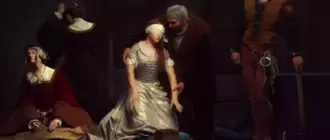
Tapestry is a kind of decorative textile art in the form of a one-sided lint-free carpet with an artistic composition on the front side. The tapestry is made by hand by cross-weaving multi-colored threads. The artistic basis for the creation of such a carpet are colored pictures on paper (cardboard), made in full size.
Tapestry is the most common name for artistic woven carpets in Russian. It comes from the name of the Flemish weavers of the Gobelin, who founded the Royal Furniture Manufacture in Paris in the middle of the 15th century. The terms “trellis” and “arras” are also used to refer to all kinds of decorative weaving products.

Types of tapestries
Crafted by skilled craftsmen, ancient or modern, tapestries are true works of art. Creating a decorative carpet requires a significant investment of time and effort, and the finished work of art costs a lot of money. Therefore, the buyers of tapestries have always been the wealthiest people: kings, wealthy nobles, representatives of the highest clergy.

Artistic tapestries can be very different from each other in the following parameters:
- The material of the warp and weft threads (from wool, silk, gold and silver threads, synthetic and artificial fibers).
- Sizes (large, medium and small).
- Appointment (for walls, curtains, curtains and pillowcases).
- Genre (religious, heroic, portrait, landscape, everyday, mythological, battle).
- The type of composition (subject or ornamental).
- Composition difficulties (single or serial).
- Weft density (the number of wefts per inch of warp threads).
- Coloristics (the amount of color pigments used).
- Artistic style (Renaissance, Baroque, Rococo, Mannerism).

Over the course of several years, several professional weavers often worked on the creation of large-scale artistic tapestries at manufactories. This made it possible to significantly speed up the process of making a large carpet. The volumetric image of the cardboard was divided into several parts, each of which was given to a separate master for work. At the final stage of production, the finished parts from the seamy side were sewn with thin silk threads into a single fabric.
History of tapestries
The history of tapestries, according to the most conservative estimates of experts, has more than 4500 years. The oldest works of this art are found in South America, in the territory of modern Peru. The samples of the artistic weaving of the ancient Incas found by archaeologists were created around 2500 BC. They are characterized by characteristic features: the abstractness of the composition and the minimum number of colors used.

The art of making decorative carpets was also common in Ancient Egypt, Babylon, Greece and Rome. This is evidenced by numerous historical documents and literary works of those times. Unfortunately, only a few examples of antique artistic weaving have survived to this day.
In China, the first tapestries appeared around 200 BC. The finest silk threads were used here for the manufacture of textiles. Chinese craftsmen have learned to make not only complex landscape and floral decorative miniatures, but also elements of festive clothing for the nobility. From China, the art of weaving spread to Japan and Korea.
In the Middle East, the technology of hand-made decorative carpets was well developed by the Arabs and Persians. The Koran forbids believers to create images of people, so Muslim craftsmen weaved multi-colored carpets with exquisite ornaments.
In Western Europe, the first tapestries appeared thanks to the Crusades at the end of the 11th century. Unlike the rulers of Byzantium and the Ottoman Empire, European rulers appreciated the role of carpets as a monumental decoration of the walls of large buildings: cathedrals, castles and palaces.
Already in the XIV century in France, England, Germany, Italy, workshops for the production of tapestries began to open en masse. In addition to large manufactories, tapestries were hand-made by monks in monasteries and servants at the homes of noble nobles.
Cardboards on religious and other topics, which served as the basis for the manufacture of tapestries, were written by outstanding masters of European painting:
- Raphael (Raffaello Santi);
- Rubens (Pieter Paul Rubens);
- Antoon van Dyck;
- François Boucher
- Francisco Goya.

Tapestries remained a popular form of applied art until the middle of the 19th century. But the rapid development of machine production of carpets and a radical change in the artistic demands of society over several decades radically changed the situation.
With the beginning of the twentieth century, tapestries have completely lost their important function of decorative decoration of the situation. As a result, the few surviving manufactories significantly curtailed production. And today only professional artists are engaged in the manufacture of tapestries. They experiment with new materials and techniques, create original works of art that are exhibited at specialized exhibitions.
Modern technologies of machine production of textiles make it possible to produce large quantities of paintings from jacquard fabric. To attract buyers, cunning sellers call them tapestries. But these pieces have very little in common with the handcrafted masterpieces of ancient craftsmen.
Tapestry collection of the 11th-16th centuries





























